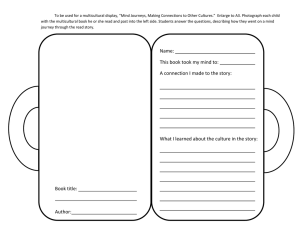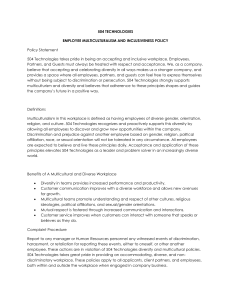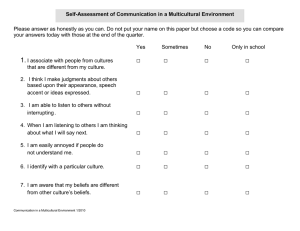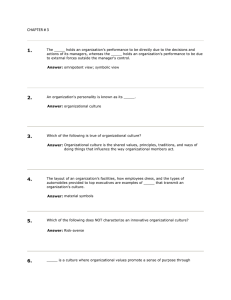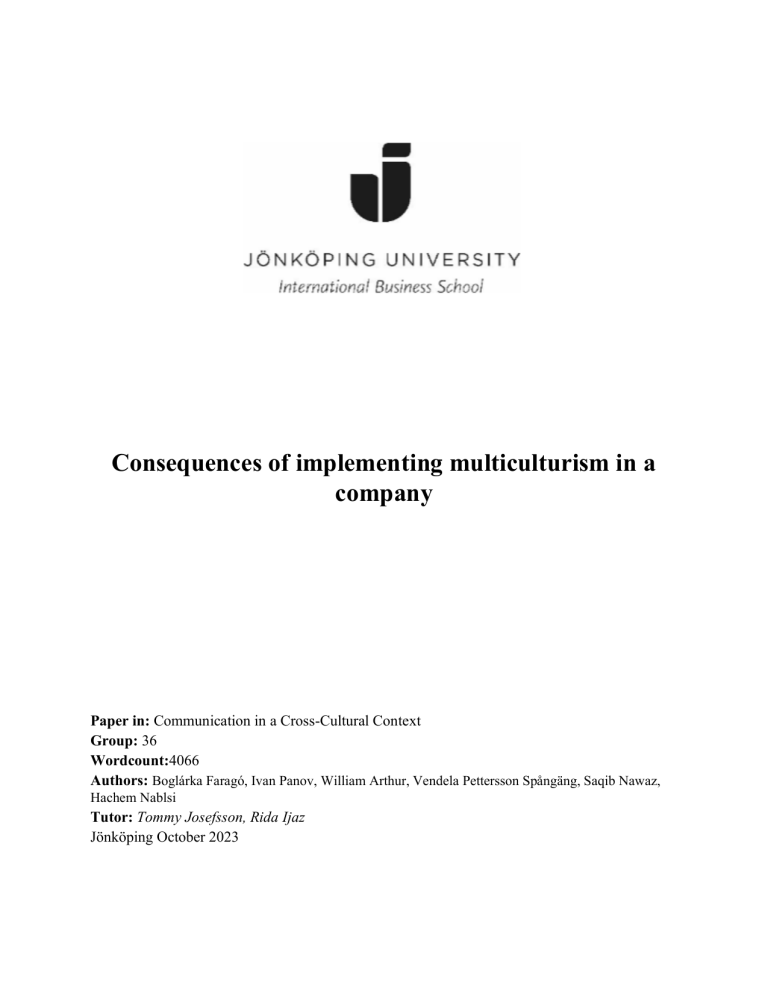
Consequences of implementing multiculturism in a company Paper in: Communication in a Cross-Cultural Context Group: 36 Wordcount:4066 Authors: Boglárka Faragó, Ivan Panov, William Arthur, Vendela Pettersson Spångäng, Saqib Nawaz, Hachem Nablsi Tutor: Tommy Josefsson, Rida Ijaz Jönköping October 2023 Table of contents 1. Abstract...............................................................................................................................2 2. Introduction.........................................................................................................................2 3. Method................................................................................................................................2 3.1 Use of AI tools..............................................................................................................2 4. Frame of Reference.............................................................................................................3 5. Theory …......................................................................................................................…...3 6. Advantages of multiculturism in a company.......................................................................3 6.1 Gender and Ethnic diversity within a multicultural company......................................4 6.2 Increased financial rewards within a multicultural company.......................................5 7. Risks of multiculturism in a company..................................................................................6 7.1 Communication problems due to a multicultural workforce........................................6 7.2 Discrimination within a company due to diverse cultures............................................7 8. Conclusion...........................................................................................................................9 9.Reference List......................................................................................................................10 Abstract: 1 The focus point of this academic paper is to investigate multiculturism in business. Multiculturism describes the process of having various cultures in one company. Implementing many cultures in one organization creates both opportunities and challenges. In this essay different perspectives of multiculturism and its consequences are being examined. Introduction In today’s developing world, businesses are increasingly identifying the necessity of embracing intercultural diversity within a firm. Intercultural companies hire a diverse set of employees with various backgrounds, sex and ethnicity offering equal opportunities. A multicultural business values different skilled employees coming from various cultures. Diversity benefits a company by sharing unique perspectives based on various cultural aspects. Entering a certain market can be challenging for a firm without previous familiarity of the culture. By developing a multicultural firm, the business will understand a new market more easily and more rapidly. Having a multicultural business might sound like the best opportunity for business success. However, that might not always be the case. With multiculturism comes opportunities and risk, and a world with many diverse cultures comes with distinctions, misunderstandings, and disagreements. Ethnicity, culture, and gender are aspects to consider when working together. The ability to understand gives an opportunity for success. Although risks and opportunities are opposite, it is important to know the consequences of a change within a firm. How should one navigate when expanding globally and what types of obstacles might occur on the way of developing an intercultural company? This report discusses the opportunities of having a multicultural company by investigating the advantages and disadvantages. It analyzes the potential risks by merging several cultures in one business. Method: This essay is based on the course book Introducing Intercultural Communication for definitions and theories. Other academic literature such as articles and websites have been used for describing and analyzing examples that relate to the topic. When locating these sources, research was used to obtain reliable and trustworthy information. Use of AI tools The only AI tools that were utilized were Quillbot and Grammarly. It was used to find synonyms for words to help better express what wanted to be said. Quillbot and Grammarly assist with paraphrasing; it began by writing our own words and then used AI to see if there was a better way to write/paraphrase what we had already written. The benefits of AI included better understanding the content and learning new terms that fit better inside the text. The challenges with using it were that sometimes the way it paraphrased the sentence was not always as we desired. Frame of reference When looking at multiculturism, we first must understand that culture defines people's lives; how we communicate, what we say, what we do and how we present ourselves. Culture is formed from our 2 experiences throughout our lives, through our beliefs and values that shape who we are now (Liu et al., 2019). With a diversity of cultures, multiculturism depicts society’s adaptation and tolerance towards diverse cultures as written by Liu. In this essay, the focus is on how companies are affected after implementing a multicultural workforce. According to Fromowitz (2014), there has been a rapidly increasing trend in migration in recent years, with the total number of international migrants in the world ranging from 175 million to 200 million. Therefore, it is no surprise that companies have started to integrate multiculturalism into their company to adapt to a new diverse society. Cantle (2014) claims that “cultural diversity and multiculturism require us to reconsider our cultural identity.” As a person socializes with a diverse community their own culture might not be as clear. Cantle (2014) argues that multiculturism has not yet adopted other aspects such as people having several identities due to ethnicity and national identity. Theory To investigate our thesis more in depth, this essay will be using Hofstede’s Cultural Dimensions, a wellknown cross-cultural theory that will be discussed and used as an analysis in the essay. Hofstede discovered six behavioural cultural dimensions that influence the behaviour of all cultures within a workforce (Liu et al., 2019). These six cultural dimensions are individualism & collectivism, masculinity & femininity, power distance, uncertainty avoidance and later short vs long-term orientation. The theory focuses on the national level instead of the individual therefore it is generalized to a particular society even though there are subcultures within as well (House et al., 2004). Advantages of a multicultural company: A multicultural workforce offers numerous advantages, such as adaptability in new markets, enhanced international business development through language skills and cultural understanding, and increased profitability. Embracing multiculturalism benefits both market success and overall company performance by fostering a diverse talent pool that provides various skills, enabling companies to offer multiple products and services and stay adaptable in a changing business landscape (Leonard, n.d). This adaptability results in quicker planning, development, and execution, with the potential to identify market gaps and meet changing consumer behaviour. Furthermore, a diverse workplace enhances problem-solving capacity and productivity, fostering healthy competition that drives process optimization and greater efficiency (Reynolds, n.d). Inclusive and culturally diverse businesses attract ambitious professionals who value personal and professional growth, and working across cultures enriches experiences and promotes a global perspective. To fully harness the benefits of diversity, creating an open and inclusive workplace is crucial. Colleagues from diverse cultures may have varying communication styles, affecting their willingness to contribute. Fostering integration among teams is essential to avoid isolation and knowledge limitations among colleagues from other countries, and addressing cultural prejudices or stereotypes is essential for maintaining company morale and productivity. Effective cross-cultural communication is vital, as language barriers, accents, idioms, and non-verbal cues can all lead to misunderstandings or offence. Understanding cultural nuances in gestures, greetings, and non-verbal communication is vital to successful multicultural collaboration. 3 A multicultural workforce has many advantages in today's global business. They fit perfectly in international expansions and projects because they understand diverse backgrounds, local cultures, and languages. Multicultural teams are very profitable for businesses because of their diverse talents and insights, leading to a wider range of products and services. Furthermore, a multicultural team adapts quickly to market changes, enhancing planning and execution. Moreover, they are creative in problemsolving by bringing different perspectives. Additionally, to fully benefit from a multicultural team, ensuring an inclusive work environment and effective cross-cultural communication is essential. Gender and Ethnic diversity within a multicultural company According to a report made by McKinsey in 2015 businesses that incorporate ethnic and gender diversity receive a higher financial outcome than companies that do not. The research was conducted on 366 companies spanning Canada, Latin America, the United States, and the United Kingdom. The outcome of the study was quite clear, companies in the top quartile of ethnic diversity had a 35% higher likelihood of making financial returns when compared to the bottom quartile. Quite similarly, the research shows that companies which incorporated gender diversity had a 15% higher probability of making financial returns when comparing the top quartile to the bottom. When combining both these statistics the report concluded that the top quartile in both gender and ethnic diversity had a 25% higher probability of financial performance compared to all other quartiles. Companies in the bottom quartile in both factors have a lower likelihood of financial performance when compared to the other quartiles. The study also claims that differing performance points to diversity being a competitive differentiator. Although the fact that correlation does not necessarily mean causation, this is empirical evidence that cultural diversity in management has positive impact on business performance in many cases (McKinsey, 2015). The theory of masculinity-femininity explains whether assertiveness or nurturing is the predominant value in said culture according to Hofstede’s cultural dimensions. A culture with strong masculine traits typically strives for material success, high assertiveness, and competition. They also put high focus on distinguishing between how men and women are supposed to act and believe. Feminine traits, however, allow more overlapping gender roles, and some traits associated with the feminine dimension are compassion, care, and concern for the weak (Liu et al., 2019). Hofstede's theory of masculine-feminine dimensions might be one contributing factor for businesses on the market. Although it is difficult to tell with full certainty there is no disregarding the fact that the companies incorporating gender diversity in their management in general reach a higher financial return. The reason for this might be that traits associated with nurturing, as described in the theory, are typically favored in teambuilding as people learn to respect and value each other. One might think that the competitive nature of the masculine culture is favored in many regards, however, to work together, build a strong collaboration and complement each other's weaknesses companies might favor the overlapping gender roles. As previously stated, masculine oriented cultures put emphasis on distinguishing how men and women should act and think. Therefore, one might assume that companies incorporating feminine traits might see a broader spectrum of opinion, thoughts, and ideas. The different perspectives given by feminine cultures might be one contributing factor that gives companies a competitive advantage. Increased financial rewards within a multicultural company Coca Cola is a fitting example of where implementing multiculturalism made the business more successful. Nowadays Coca Cola has reached across the world to every nation on the planet, however this 4 was not always the case. In 1929, Coca-Cola set out to expand their market to Africa, with this expansion there were several difficulties that would arise. The two main challenges were: bad infrastructure and local retail made up mostly of micro businesses. To solve these problems, Coca-Cola had to develop several different strategies to increase their sales. In 1999, they developed a model called Micro Distribution Centre (DMC) to spread the product to shops, vendors, and other micro businesses. To accomplish this, Coca Cola appointed entrepreneurs and dedicated salesmen from the local area with profound knowledge of cultural customs and were trusted in the local community. The DMC would use any means necessary to deliver the products including hand delivery, pushcarts and even delivery by canoe. This model was extremely successful and is today used in 19 countries in Africa and Asia. It was by the virtue of multiculturalism and incorporation of locals that led to the success for Coca Cola in Africa (Sihite, n.d.). Another example of a business succeeding due to multiculturalism is Rakuten, Inc. Originating from Japan the company now in 29 countries and regions. However, internationalization is quite a recent phenomenon. Similarly, to many Japanese companies Rakuten had a reputation for their distinct management style dealing with a strict hierarchy. In 2010 Rakuten made headlines when the management made the decision to invest in internationalization and changing their primary language to English. This move was criticized by employees and Japanese media alike however the company stood firm. Rakuten’s long-term goal was to go global, and to do this, they had to incorporate top talent internationally. Today the company has a 50/50 split in both Japanese and international executives and the global success is very much due to this internationalization (Sihite, n.d.). Contrasting cultures make different approaches to challenges and opportunities which leads to more innovation and better creativity. Every culture engages the world differently depending on the lens which they observe the world, this gives unique perspectives, encourages new ideas and is beneficial for any business. Multiculturalism is also a great factor for customer service. Customers come from all walks of life and having diversity in the workforce often makes a great impression regardless of if the employee speaks the language or simply knows the correct customs. Furthermore, multiculturalism builds strong workplace environments where employees can feel appreciated for who they are and the unique skillset they provide (Leonard, 2019). Companies incorporating multiculturalism also see a higher financial return in general than companies that do not. The examples given by Coca-Cola and Rakuten, Inc. are two perfect examples of how a team might proceed to expand their markets internationally. The success achieved locally by Coca Cola was not directly due to executives abroad, albeit potentially indirectly since they developed the model. The cultural expertise given by the locals was a strong contributing factor in supplying the area with the product efficiently. Quite similarly, Rakuten achieved global success by dropping the strict Japanese work culture to embrace internationalization even against heavy opposition. This is thanks to the new perspectives given to the company by including diverse backgrounds and cultures. Risks of multiculturism in a company: Despite the advantages, recruiting overseas talent can pose difficulties within the human resources department. Managing the varying employment laws and frequently changing visa requirements in different countries can be intricate (Reynolds, n.d). Additionally, it is essential to think beyond visas and consider accommodations for a culturally diverse workforce, like providing prayer spaces or acknowledging various cultural holidays. These considerations and accommodation may result in increased business expenses and logistical complexities. 5 Colleagues from diverse cultures can also bring varying workplace attitudes, values, behaviors, and etiquette. While enriching in a diverse environment, these differences can occasionally lead to misunderstandings or conflicts (Reynolds, n.d). Variances in formality, organizational hierarchy, working hours, punctuality, confrontation, and conflict resolution can all be potential sources of tension among team members from diverse backgrounds. Additionally, differing approaches to teamwork collaboration and the emphasis on individualism versus collective consensus can reflect underlying cultural values, impacting productivity. Creating and instituting diversity guidelines and policies is critical to ensure that employees are culturally aware. By setting rules about acceptable and ethical behaviour in the workplace, you can clarify how employees of diverse backgrounds should interact with each other. Review local laws surrounding discrimination in the workplace and include those regulations within company policies. Be sure everyone knows what constitutes discrimination, from the leadership team to the front-line employees. Workplace conflicts often happen because of different communication styles in diverse cultures. For example, some cultures prefer bows instead of handshakes, while others find direct eye contact impolite, yet some consider it a sign of honesty and trust. Verbal communication styles also differ. In some places, speaking directly to a superior may be seen as rude, while in others, it is seen as efficient, regardless of their seniority. Communication problems due to a multicultural workforce Different attitudes towards hierarchy and trouble with fluency are quite simple examples of what a company needs to be prepared for when working in a multicultural setting. Typically, Western cultures favor more direct and open ways of communication, while many others rely on indirect ways of communication. For instance, an American project manager with Japanese team members faced difficulties due to indirect communication in the Japanese culture (Jeanne M. Brett at el, 2006). Nevertheless, discrimination against accents is still an ongoing issue for many companies as there was a study conducted in 2006 that showed a significant 76% of employers openly admitted to discriminating against job candidates based on their accents (Professor Devyani Sharma, 2022). With the adaptation of digital workplaces, the problem has become even worse as now there are more opportunities than ever for foreign workers (Employee resources, 2022). Accent bias also has a negative effect on the entire organization. When employees feel isolation or lack of respect, just because of how they speak, they are less likely to perform better in their workspace. Eventually, their creativity and productivity could decrease, which could cost the company. Moreover, stereotyping is connected to accent discrimination and some of the accent bias may include; making assumptions of someone’s intelligence, assuming that non-British people are less capable of communicating, excluding members from conversations and many others (Employee resources, 2022). In one case, a Filipino nurse indicated that her director gave her a sharp criticism because of her thick accent. She ended up suing the hospital for national origin discrimination (Janice Gassam Asare, 2022). These examples can be connected to one of Hofstede’s Cultural dimensions; power distance. This dimension is deeply connected to the subject matter as it refers to the extent to which a culture tolerates 6 inequality in power distribution or to which power, prestige and how wealth is distributed within a culture (Lui et al, 2019). Using this example, the countries with larger power distance, such as Japan, inequalities among people are both predictable and desired (Lui et al, 2019). It is quite common to give a huge amount of respect to elders in that part of the world and making a simple gesture like removing your hat when speaking to them and even using more formal vocabulary are signs of respect. On the other hand, cultures with smaller power distance emphasize equality among people, highlighting that there should be equality for all the people from different power levels (Lui et al, 2019). With the most common example being the USA. However, current trends have shown that the Japanese workers are starting to be a lot more vocal and less afraid to criticize their leaders more often. Thus, the cultural values between these two countries may fade in the future (2023). Discrimination within a company due to diverse cultures There are several risks associated with diversifying the workforce which may hinder the overall performance of the organization/companies. Diversification of diverse cultures in the workforce can lead to short-term cost outlays (Emma, L. 2019), miscommunications and conflicts (Dhuppar, S. 2015). Some employees and managers may not react positively to the inclusion of people from other ethnic groups (Dhuppar, S. 2015) and may end up making the workplace environment a difficult one for their other colleagues. According to survey (RaceAtWork. 2015) done by Business in the Community in United Kingdom, it was shown that racial harassment and bullying was frequent in the office culture in the UK. The survey included 24,457 employees and 30% of those employees were either victims or witnesses of racial harassment from their managers, colleagues, and customers in the year 2015 alone. Even though diversification may sound and seem like a captivating business idea but there always remains a high chance that inclusion of employees from other cultures in the workplace might obstruct its smooth flow of operations. Diversification brings people with different mindsets to the table who may have a quite different approach to achieving their task than their other counterparts and because of this factor there may be clash of approaches (Cheah, L. 2013) between the employees or managers in the company. Other factors can include language, gender, and religion. Organizations face difficulties in managing diversity at individual as well as group levels especially when the employees come from different religions (Sharma, A. 2016). Religion can lead to individuals making some financial sacrifices which may lead to a low-income generation. Such was seen in France. France has been a regular destination for immigrants from the mid 19th century and ratio of immigrants coming to France has been stable ever since. These migrants came from different corners of the world and had belonged to diverse cultures, ethnicities, and religions. The French model of equality and integrating immigrants and their descendants had its shortcomings (Klarsfeld, A et al. 2010). The French model of equality focused more on the collective aspect of the society, and it denied any individualistic differences. According to (Klarsfeld, A et al. 2010),” In the French conception secularism, religion is a private matter. Everyone is free to practice his/her religion if not interfere with other people's freedom of beliefs and with the laws of the Republic.” During the 2000’s there were many litigations in France in which employees demanded the right to practice their religion in the workplace, or be given exemptions from certain tasks, or getting expelled or disciplined for showing religious interests. These examples relate to individualism and collectivism which are one of the cultural dimensions the essay will focus on; the theory describes the differences between individualistic and collectivistic cultures. Guirdham et al, (2017) explains that individualistic cultures are more open, and the significance 7 of equality and your own goal is more essential than the group. Personal achievements and personal goals are valued in society which lead people to pursue and develop their own abilities. Important values in an individualistic culture include ambition, the right of privacy, and working to pay your own bills rather than relying on others. Allowing others to speak is vital in an individualistic culture because it allows an individual to share their own ideas and opinions. On the other hand, collectivistic cultures focus on the group as a whole and not as an individual. One’s own goals are of less significance in society than preserving the culture they are in as a group. The important values within a collectivistic culture are keeping traditions, loyalty towards your partner, family and friends and showing politeness toward the people you meet (Liu et al., 2019). According to a study (Hui & Triandis , 1986), collectivistic cultures tend to be more conscious of other people's opinions and the need to fit into society due to their cultural values such as putting their own values below the group. By looking at this theory, the distinction between individualistic and collectivistic cultures can be used to look at examples of real-life events and analyze them. From the above examples it can be seen how individualistic and collectivistic actions made significant impacts to the cultures overall. Firstly, talking about individualism, Native employees in United Kingdom, which is considered a highly individualistic country according to Hofstede’s (1980) study, regarded their individual say more important than the collective culture of their workplace. They did this by indulging in racial and ethnic discrimination in the workplace while completely disregarding how their individual actions affected the overall positive culture of their workplace or company. The example of the old French model of Equality and Integration of immigrants adds to the Hofstede’s (1980) theory of collectivism. With the rising number of immigrants coming to France there was an increase in the workplace diversity, which also included religious diversity. The religious employees demanded their right to practice their religion in their workplace, or that they refrained from doing certain tasks in the workplace because of their religion. Since France, at that time, paid more heed to the collective aspect of the French society, it disregarded any individualistic differences there were between people. Individualism was only allowed if it did not interfere or affect the collective belief of the people or republic. And because of this disparity, there were many legal cases because of employees being mistreated because of their religious interests. Slowly but gradually, France realized the shortcomings in their way of enforcing equality over everyone. Conclusion Throughout the essay, multiculturalism's importance was analyzed in a variety of ways and factors. From our analysis it has been proven that for a business to function as a multicultural company with a diverse workforce there comes both risks and opportunities. Having a diverse set of employees facilitates expansion of a company and allows the company to understand local structures and the language of a new market. Bringing different perspectives makes it easier to adapt to further levels using unique views, innovative ideas, and a higher sense of creativity. Throughout the essay, multiculturalism's importance was analyzed in a variety of ways and factors. Expansion increases the knowledge of a brand and will spread the world of a company. Statistics show that having both gender and ethical diversity within a company positively increases the profitability of financial performance. A diverse workforce does not only facilitate a company’s financial success. Furthermore, it increases the value of the company from a customer point of view. Being able to reach its customers is vital for a company. Connecting customers and company comfort will occur, which will lead to higher customer assessment. Coca cola and Rakuten 8 are two companies showing that internalizing increases success. Rakuten decided to change its management style by letting new perspectives of diverse cultures in, which led to a favorable global outcome. Having a diverse workplace brings many advantages to the table. However, the disadvantages exist as well. Considering that diverse cultures have various traditions, ethics and manners, a company may have difficulties meeting all employees' expectations. Different attitudes, behaviors and etiquette may result in conflicts and misunderstandings. Crucial factors within a workplace, for instance working hours, punctuality and formality may differ from culture to culture which in conclusion could cause potential misinterpretation which in turn can affect the organization. Having clear and structured guidelines of regulations is important for a company working with employees with diverse backgrounds to prevent any argumentation. Reference list: Ahmed, A. (2020). Culture Awareness in the Workplace Retrieved October 12, 2023: https://smallbusiness.chron.com/culture-awareness-workplace-737.html Business in the Community. (2019). Race at Work 2015 (bitc.org.uk) https://www.bitc.org.uk/report/raceat-work-2015/ Cantle, T. (2014). National identity, plurality and interculturalism. (85(3): 312–319). Political Quarterly. Cheah, L. (2013). Why workplace diversity is important for every organization. Retrieved October 4, 2023: https://bit.ly/2JweWEY 9 Cultural Dimensions in the United States vs Japan, (2022). Retrieved October 12, 2023: https://studycorgi.com/cultural-dimensions-in-the-united-states-vs-japan/ Dhuppar, S. (2015). Managing Workplace Diversity Challenges and Strategies. International Journal of Research, 2(3): 346-351 Emma, L. (2018). Advantages and Disadvantages of Diversity in Workplace. Retrieved October 3, 2023: https://bit.ly/1jdaWY0 Employee resources. (2022). Accent bias in the workplace – does it really exist? Retrieved October 12, 2023: https://getkonsistent.app/accent-bias-in-the-workplace/ Fromowitz, M. (2014). ´Multiculturalism: The unstoppable global trend: Opinions. Campaign Asia. Retrieved October 4, 2023: https://www.campaignasia.com/article/multiculturalism-the-unstoppableglobal-trend/426053 Gassam Asare, J. (2022). Accent Discrimination Is Still a Pervasive Issue in the Workplace, Research Finds. Retrieved October 12, 2023: https://www.forbes.com/sites/janicegassam/2022/11/18/accentdiscrimination-is-still-a-pervasive-issue-in-the-workplace-research-finds/?sh=4fe066f2697e Guirdham, Maureen., & Guirdham, Oliver. (2017). Communicating across Cultures at Work (4th edition). London: Palgrave House, Robert J., Hanges, Paul J., Javidan, Mansour J., Dorfman, Peter W., & Gupta, Vipin (eds.) (2004) Culture, Leadership and Organizations: The GLOBE Study of 62 Societies. Thousand Oaks, CA: Sage Hui, Harry, C., & Triandis, Harry, C. (1986). Individualism-collectivism: A study of cross-cultural researchers. Journal of Cross-Cultural Psychology. 17(2): 225–248. Hunt, D. V., Layton, D., & Prince, S. (2015). Why Diversity Matters. Retrieved October 5, 2023: https://www.mckinsey.com/capabilities/people-and-organizational-performance/our-insights/whydiversity-matters Jeanne, M., Brett., Kristin J., Behfar., & Mary (Molly) Kern. (2006). Managing Multicultural Teams Retrieved October 12, 2023: https://hbr.org/2006/11/managing-multicultural-teams Klarsfeld, A., Laufer, J., & Bender, A.F (2010) Equality and Diversity in the French context https://www.researchgate.net/publication/281597067_Equality_and_Diversity_in_the_French_Context Leonard. K (n.d), (2019) The Advantages of Multiculturalism in the Workplace. Retrieved October 4, 2023: https://smallbusiness.chron.com/advantages-multiculturalism-workplace-15239.html Liu, S., Volčič, Z., & Gallois, C. (2019). Introducing Intercultural Communication: Global Culture and Contexts (Third Edition). London SAGE Publications. 10 Professor Devyani Sharma. (2022). Talking proper – could accent bias harm your job prospects? Retrieved October 12, 2023: https://www.qmul.ac.uk/sllf/research/featured-research/could-accent-biasharm-your-job-prospects/ Reynolds. K (n.d). 13 benefits and challenges of cultural diversity in the workplace. Retrieved October 4, 2023: https://www.hult.edu/blog/benefits-challenges-cultural-diversity-workplace/#creativity Sharma, A. (2016). Managing diversity and equality in the workplace. Retrieved October 4, 2023: https://doi.org/10.1080/23311975.2016.1212682 Sihite, A. (n.d.) 3 Impressive Examples of Cross-Cultural Management Retrieved October 12, 2023: https://managebetter.com/blog/3-impressive-examples-cross-culturalmanagement 11
